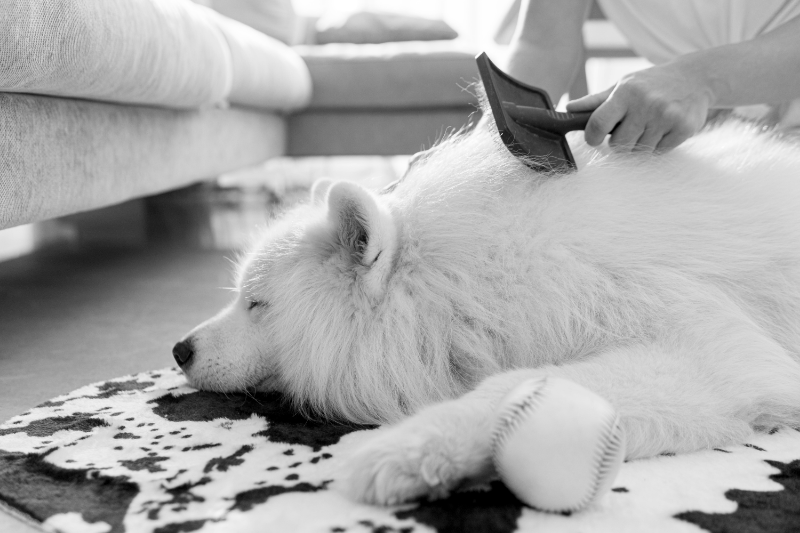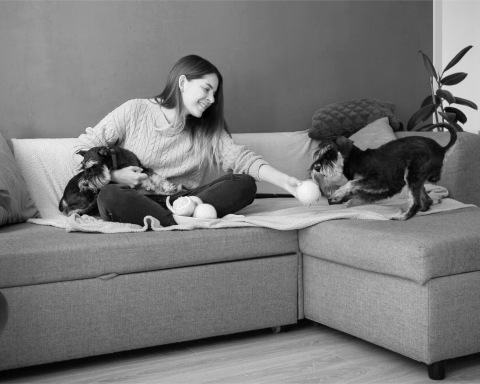You’ve just had a very tiring day. When you enter the house, you are immediately greeted by your fur baby, whether it’s a cat or a dog. What do you feel? The burden on your shoulders suddenly disappears, thanks to the warm welcome from your furry friend.
However, have you ever had to see home furniture scattered everywhere, a sofa full of scratch marks, and the smell of feces spread throughout the house? Or even the worst thing — you find your furry friend suffering after accidentally mistaking a chocolate bar on the kitchen table for food.
Of course, you don’t want these things to happen for the sake of your mental peace and your pet’s safety.
To solve this problem, you need to take immediate action to make your little friend live happily with you. Discover how to transform your ordinary house into a pet-friendly home! Keep reading to learn design tips and tricks for a space both you and your furry friends will love.
What are pet zones?
Pets at home offer comfort during stressful times, like cuddling with them after a busy day. Taking care of them brings joy and reduces anxiety. Having pets also provides companionship, security, and resilience. It is just like living with a little companion who is always there for you during your hard times.
Read more: The Healing Power of Pets: How Loving Animals Improves Your Well-Being
Building a bond with pets is like a mutual relationship. They boost your mental well-being, so making them feel safe and comfy is vital. You can show your concern for them by creating specific pet zones at home to cater to their needs and foster harmony among family members.
You need to pay attention to several important areas to create a pet paradise in your home: feeding areas, play areas, sleeping spaces, and potty areas. Each area has a designated use, and proper organization will make your and your pet’s living spaces much more comfortable. But more on that later.
Benefits of organizing pet zones at your home
Organizing dedicated pet areas within your home could bring several benefits, not only for you but also for your little friend. These benefits include:
- Cleanliness. Pet zones promote a clean and hygienic environment by providing designated areas for activities such as eating, sleeping, and eliminating waste. This contains messes and makes it easier for you to clean up after pets. It also helps to minimize odors throughout your house.
- Better management of supplies and accessories. By understanding their routine and favorite things, you can keep essentials like food, water, toys, and grooming supplies organized and easy to find.
- Behavior management. Having designated pet zones at your home can aid in training and behavior management, as pets learn to associate certain areas with specific activities, such as using a litter box or scratching post. Therefore, you will not find them scratching your sofa.
To-dos for a pet-friendly home
Organizing your home by applying design principles focused on your pet’s needs can lead to enhanced well-being and favorable behavioral changes. This approach aims to provide a comfortable and secure environment for your little buddy, resulting in reduced stress levels and higher levels of engagement with their surroundings.
Thus, there are several key steps for you to pay attention to transform your ordinary living space into a pet-friendly home, whether you are planning on implementing dog room ideas or cat room ideas.
Create designated areas
Pet zones at home can be located outdoors or indoors to support pets’ various activities (i.e. feeding area, play area, sleeping space, and litter trays or potty area). In creating pet designated area, you can try to implement these practical steps:
Feeding area
A feeding area in your pet’s space is where they eat and drink. It usually has bowls for food and water. It’s best to put this area where your pet can easily reach it during meals. Keep it clean to minimize bacterial contamination.
Having a specific feeding spot in your home keeps messes contained and makes cleanup easier. It also helps you monitor your pet’s food and drink intake more effectively each day for their optimal health. Here’s how to create a feeding area:
- Select an easily accessible area in your home where your pet can comfortably eat without disturbances.
- Put the feeding area indoors to keep the food and water supply stay clean.
- Use separate bowls for food and water to maintain hygiene.
- Place the feeding area on a surface that’s easy to clean, such as tile, laminate, or hardwood floors.
- Place a washable mat or tray underneath the bowls to catch any spills or crumbs.
- Wash food and water bowls daily with hot, soapy water and disinfect them regularly to prevent bacterial buildup.
Play area
The play zone area is where your pets can play and exercise, which is crucial for their health and happiness. It includes toys, structures, and games to keep them entertained and prevent furniture damage.
Having a designated play area for your pets offers many benefits. It boosts their physical and mental well-being by providing exercise and stimulation, reducing boredom and behavioral issues. Plus, it strengthens your bond with them through interactive play, enhancing your companionship.
Here are some tips for creating a play area:
- Choose an area in your home (outside or inside) that is spacious enough to accommodate your pet’s activities.
- Ensure the space is free from hazards such as sharp objects, electrical wires, or toxic plants.
- Incorporate climbing structures such as cat trees, shelves, or platforms for cats.
- Offer a variety of toys such as balls, stuffed animals, puzzle toys, and interactive feeders.
- Place scratching posts or pads in the play area to satisfy your pet’s natural scratching behavior.
- Keep the play area clean by regularly vacuuming or sweeping to remove pet hair and debris.
Sleeping space
The sleeping space is a safe and cozy place for them to rest peacefully. It helps them feel secure and establishes their territory in your home, boosting their confidence and behavior.
Pets may have unique sleeping habits, so giving them their own space ensures everyone sleeps soundly. Plus, it keeps your sleeping area clean from dirt they might track in.
- Choose a quiet and minimally distracting area in your home for your pet’s sleeping space.
- Ensure the sleeping area has good airflow and stays warm. You can put it near the window for warmth and sunlight, especially for a cat house.
- Select bedding that is comfortable, clean, and in good condition for your pet. For dogs, build a dog area at home with durable materials that can withstand potential chewing.
- Cats often enjoy elevated sleeping spots for security and observation. Provide options such as cat trees or shelves near windows for them to perch on.
Litter trays or potty areas
The litter tray area is where a cat goes to do its business (urinate and defecate), usually a box filled with litter. It’s crucial for maintaining good elimination habits and cleanliness. Cats prefer clean and well-kept litter boxes, so keeping them tidy encourages regular use.
Having multiple litter boxes in different areas can help maintain harmony if you have more than one cat. Make sure they’re spacious and clean to ensure comfort and proper elimination habits. Place them away from the kitchen for hygiene, and clean them a few times a day.
Unlike cats, dogs usually go outside to relieve themselves. Consider building an outdoor dog house with a potty area for them and install a dog door for easy access.
- Consider placing it in a corner or out-of-the-way spot to provide privacy for your pet.
- Choose a litter or potty material that suits your pet’s preferences and needs. For cats, options include clumping or non-clumping litter, while for dogs, you might use puppy pads, artificial grass, or a designated outdoor area.
- Ensure the litter tray or potty area is large enough for your pet to use comfortably.
- Regularly clean and maintain the litter tray or potty area to prevent odors and keep your pet comfortable.
- Ensure that the litter tray or potty area is easily accessible to your pet, especially for older or disabled animals.
Implement storage hacks
Effective storage solutions are essential for maintaining a neat and organized home, especially when sharing your living space with your little friend. Proper storage of pet food is crucial to ensure its quality and safety for your furry friends.
Here are some key points for you to pay attention to:
- Dark container or cabinet with room temperature. Storing pet dry food at room temperature in a dark place preserves its nutritional value and prevents degradation. Exposure to sunlight can cause vitamins and nutrients in the food to break down, reducing its overall quality.
- Airtight containers. Using airtight containers maintains the freshness of pet food, especially for wet food. These containers prevent moisture, air, and pests from getting into the food. Additionally, airtight seals help retain the aroma and flavor of the food, making it more appetizing for your pets. Ensure to refrigerate wet food.
In addition to pet food, you can put their toys and other accessories in a container box after playing with them. You can also implement a labeling method to make it easier to gather their items whenever you want to play with them again.
Read more: Creative Ways to Utilize Your Under-Stairs Storage
Incorporate pet-friendly design elements
Selecting pet-friendly design elements involves taking into account the fundamental biological and behavioral aspects of your pets. This includes designing comfortable spaces tailored to their needs.
There are several strategies for you to incorporate these design elements to ensure your pet’s well-being.
- Adding cozy bedding. Providing cozy beds, soft blankets, and cushions in quiet corners or designated pet areas.
- Minding your pets’ size and preference. Consider the size and preferences of your pet when choosing furniture and accessories to ensure they have ample space to move around comfortably.
- Incorporating interactive elements. These elements can keep pets mentally stimulated and physically active. This can include installing scratching posts, climbing structures for cats, interactive toys, and puzzle feeders that encourage natural behaviors like hunting and exploration.
- Selecting appropriate materials. Materials should be pet-friendly and easy to maintain, such as bamboo or cedar which are durable and resistant to scratches, making it ideal for furniture and flooring.
- Creating designated play and relaxation areas. These areas should be free from potential hazards to promote a safe environment for your furry companions. This includes securing hazardous items, keeping toxic plants out of reach, and using pet-friendly cleaning products and finishes.
In conclusion
Creating specific pet zones within your home is not just about enhancing the aesthetics of your living space.
It is about prioritizing the well-being and safety of your beloved furry friends. By implementing designated areas for different activities, such as feeding, playing, sleeping, and eliminating waste, you can create a harmonious environment that caters to your pet’s unique needs while promoting cleanliness and hygiene throughout your home.
To take action and transform your ordinary house into a pet-friendly home, consider creating these designated areas and implementing effective storage solutions to keep pet supplies organized and easily accessible. Additionally, incorporating pet-friendly design elements, such as comfortable bedding, interactive toys, and safe materials, can create a welcoming environment for your pets.
So, why wait? Start implementing these pet-friendly design tips today and enjoy a space that fosters companionship, well-being, and joy for everyone in your household. Your furry friends will thank you for it!
If you would like to see more resources on organizing for pets, check out the Home Organization Science Labs. The lab uses the research of the Institute for Life Management Science to produce courses, certifications, podcasts, videos, and other tools. Visit the Home Organization Science Labs today.
Photo by Freepik



